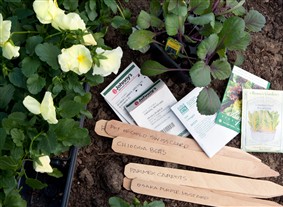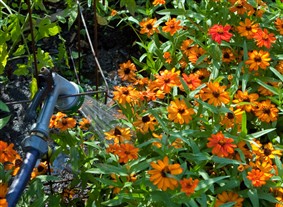Planting the Spring Garden
Views: 5976

It’s a glorious spring day—57 degrees and sunny—which means we strip off our coats and put on T-shirts, shorts, and flip flops here in the Midwest to work in the spring garden.
Transplanted southerners might find that temperature a bit nippy. I’ll keep my jacket on the hook by the door. The fickle weather might bring clouds and frost tomorrow.
Celebrate the spring by planting the cool weather crops. Lettuce, kale, mustard greens, and greens for salad are easy to grow from seed, but there are other delights on the spring garden menu.
Transplants for the Spring Garden
You can have a glorious spring garden more quickly by setting out transplants. Your local nursery and even your grocery store have flats of baby plants ready for purchase. Here is what to throw in your cart along with the milk, cheese, and bread. Hold the tomatoes and the peppers.
• Swiss chard can go in the ground now. Bright Lights is a popular variety. The stems show a rainbow of colors—red, orange and yellow. Don’t overlook this great plant. It can stay in the garden all season to eat or just look pretty as you wish. It can even dress up a pretty spring container.
• I just planted some Ruby Perfection seedlings because I like coleslaw made with red cabbage. By early summer, the heads will be ready for chopping. Cabbage does best spaced at least 15 inches apart.
• Broccoli can be set out now because, like other cool weather crops, it tolerates frost and even a little snow. Broccoli doesn’t like hot weather. If the spring season is short and the weather turns sweltering, the immature green heads will sprout yellow flowers (which are still edible). Sometimes broccoli is better as a fall crop when the temperatures stay cool.
• Beets are easy to grow from seed, but I’ve seen them for sale as plants. If you want an instant garden, plant them as starts. I have seen Bulls Blood with its dark red leaves at the nursery. Once it’s in the ground, you can harvest some of the side leaves for salads.
• Onions and shallots can be planted in cool spring soil. For some reason, they are called sets. Bunching onions, grown for their stalks, or bulb onions can be planted in the kitchen garden or even the perennial border. They’ll be ready for harvest in the summer when the green tops flop over.
More Tips
• Don’t plant potatoes you find in the produce section at the grocery store in the garden, rather plant seed potatoes ordered from mail-order catalogs or grown especially for gardeners. You can chit the potatoes by cutting large ones into smaller pieces, making sure each piece has two or three eyes and allowing them to dry overnight. Place them in fertile soil about 12 inches apart and cover with a couple inches of soil.
• Peas can still be planted outside now. I save some pruning chores until spring and use the cut branches for the climbing peas. Some tall climbing varieties need more support, but I find a few twigs stuck in the soil keep the short vines just fine.
• Look for rhubarb in pots. Spring is the best time to find it in the nursery. Rhubarb should be planted in a permanent location where it will flourish into a large leafy plant. It will last for years. If you plant some this year, you’ll be harvesting red or green stalks next spring for pies and sauces.
And finally, don’t overlook the ubiquitous pansy for the kitchen garden. I never grow tired of the vast array of cheery colors. They are perfect for containers or as a border around the vegetables. There aren’t too many annuals that thrive in cool spring weather, and these you can eat if you wish.
Meet Jennifer Bartley
Jennifer Bartley grew up on a ravine near an ancient Indian mound. She remembers spending glorious childhood days picking wildflowers and playing in an old,…
Jennifer's Recent Posts

Hand Watering the Kitchen Garden








